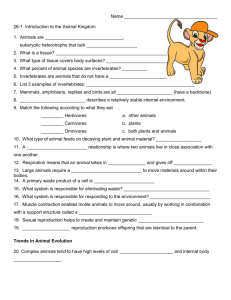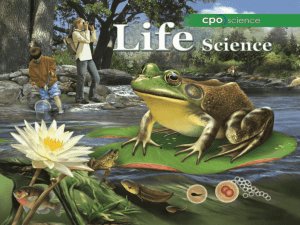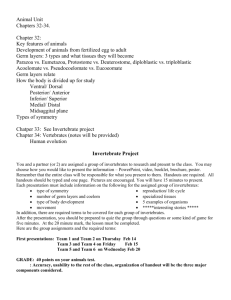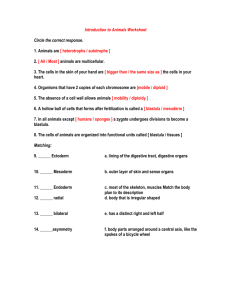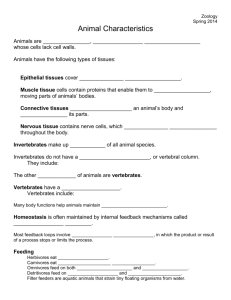Introduction to Animals Section 1
advertisement
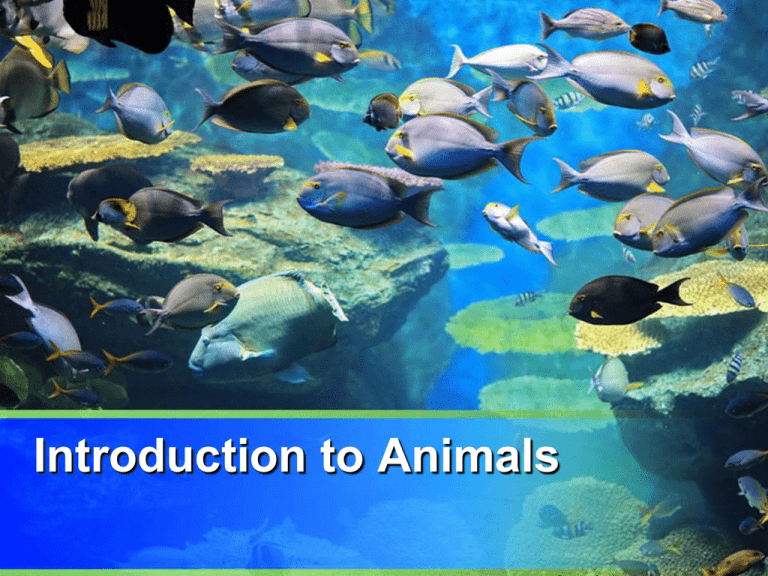
Introduction to Animals Section 1: Nature of Animals I. Vertebrate vs. Invertevrate A. Vertebrate – has vertebrae or backbone surrounding nerve cord (spinal cord) B. Invertebrate – no backbone surrounding nerve cord; 95% of animal species!!! II. What is an animal? A. Multicellular – each cell depends on the functions of all other cells 1. Specialization – a cell has developed to perform one specific function; a division of labor among the cells 2. Cell Junctions – connections between cells that hold them together to make a tissue • Review: Tissue – group of specialized cells working on one function together B. Heterotroph – animals must obtain organic molecules (a.k.a. food) through ingestion. C. Sexual Reproduction & Development 1. The 1st cell is a fertilized egg – diploid zygote 2. Differentiation – zygote divides to produce more cells, which grow & “learn” the function(s) they will be responsible for. ***Differentiation is the process that results in Specialization!! D. Movement 1. Animals have muscle and nerve tissue (or at least cells). 2. Neurons (nerve cells) use electrical signals to trigger muscle movements. III. Origin & Classification of Animals A. Flagellated, Colonial Protist gave rise to early invertebrates. B. An invertebrate gave rise to vertebrates Section 2: Animal Bodies I. Symmetry – describes organization of an animal’s body, if parts are arranged in mirror images of one another. A. Asymmetry – body shows no symmetry • Ex: sponges, corals B. Radial Symmetry – body has 2 or more planes of symmetry, body is arranged in a circular fashion • Ex: star fish, anemones, sand dollars C. Bilateral Symmetry – body has only one plant of symmetry • Ex: fish, mammals, birds (all vertebrates!) II. Anatomical Positions – term that describes areas of the body 1. Anterior – towards the head 2. Posterior – towards the tail 3. Dorsal – towards the upper part or back of a standing animal 4. Ventral – towards the lower part or belly of the standing animal 5. Medial – towards the midline plane that separates right and left sides of a body 6. Inferior – below or under a body part 7. Superior – above or over a body part 8. Caudal – toward the back or tail 9. Cranial – toward the front or head III. Body Tissues & Cavities A. Germ Layers – tissue types found in embryos 1. Sponges have none 2. Cnidarians & Ctenophores have 2 germ layers (anemones and jellies) 3. All other animals have 3 germ layers • Are mostly bilaterally symmetrical • Show Cephalization – concentration of sensory organs toward the anterior end (in the head) B. Body Cavities – fluid-filled space between digestive tract and outer wall of the body IV. Animal Phyla A. Ten Invertebrate Phyla • • Very diverse in symmetry & body organization Ex: sponges, insects, starfish B. One Vertebrate Phylum (Chordata) – all animals have the following structures at one point in life, but many lose them as they mature 1. Notochord – firm, flexible rod of tissue 2. Dorsal Nerve Chord – located just above the notochord; gives rise to spinal cord 3. Pharyngeal Pouches – our pockets of digestive tract at anterior end 4. Postanal Tail – muscles near posterior end Section 3: Invertebrates vs. Vertebrates I. Invertebrates – over 95% of animals A. Symmetry – radial or bilateral 1. Sponges are asymmetrical 2. Bilateral allows for cephalization B. Segmentation 1. Some invertebrates are segmented, the body is made of repeating units (earthworm) 2. Segments can be almost identical (earthworm) or very different (lobster). Segmentaion C. Body Support – what holds the body up 1. Simple skeletons (sponges) 2. Fluids inside the body cavity push out on the outer covering of the animal (roundworms) 3. Exoskeleton: rigid, outer covering that protects body & must be shed as the animal grows. A new exoskeleton will grow in its place (animal is very vulnerable at that time). D. Respiratory & Circulatory Systems 1. Respiratory – exchange of gases (CO2 & O2) • Most invertebrates exchange gases directly through their outer covering or gills 2. Circulatory – moving fluid through the body to transport O2 and nutrients • Open Circ. System: blood is pumped into body cavity (no blood vessels) • Closed Circ. System: blood travels through body cavity in vessels Open vs. Closed Circulatory Systems E. Digestive & Excretory System 1. Digestion – break down of food to gain nutrients • Sponges: digestion occurs in each cell • Digestion can occur in a central chamber (Cnidarians) • Digestion can occur in a gut E. Digestive & Excretory System (cont) 2. Excretion – release wastes from the body • Aquatic invertebrates: waste is released as ammonia • Land invert.: ammonia is converted into a less toxic substance F. Nervous System 1. Using electrical impulses to control body functions 2. Large amounts of diversity among invertebrates!! G. Reproduction & Development 1. Hermaphrodites – single animal produces both male and female gametes (earthworm) 2. Indirect Development – enter a larval stage, then mature into an adult • Ex: ? 3. Direct Development - no larval stage; at birth, animal already resembles adult form • Ex: ? II. Vertebrates – all have bilateral symmetry!! A. Body Support 1. Endoskeleton: internal skeleton that supports large, heavy bodies B. Segmentation 1. All vertebrates are segmented somewhere on or in their bodies (ribs, vertebrae) C. Body Coverings – Integument System 1. Aquatic Vertebrates: have moist skin which allows for gas exchange through the skin 2. Land vertebrates: skin is watertight 3. Feathers & Fur: expel water & insulate body D. Respiratory & Circulatory Systems 1. Respiratory: aquatic vert. use gills; land vert. use lungs 2. Circulatory: closed system with a chambered heart E. Digestive & Excretory Systems 1. Digestive: have a gut running anterior to posterior 2. Excretion: converts ammonia to less toxic substance; filters blood through kidneys F. Nervous System 1. Brain & nervous tissue is organized into an efficient system. G. Reproduction & Development 1. Embryos can develop in an egg outside mother’s body or inside body in a uterus. 2. All vertebrates undergo direct development!


